“Destination Asia:
Non-strict correspondence”
Artists - participants of the exhibition
(Click on the image to see full view)
PAKISTAN:
Quddus Mirza&Nadia Shaukat
Quddus Mirza is a painter, art teacher, independent curator and art critic. He is one of the most well known artists of his generation in Pakistan. Graduated from the National College of Arts, he later acquired MA in painting from the Royal College of Art. He has shown in numerous group shows, and had several personal exhibitions held in different cities of Pakistan and in London.
Nadia Shaukat studied at National College of Arts and then acquired MA in art from Chelsea School of Art, London, UK. Nadia Shaukat has shown in Lahore, Karachi, Islamabad and in UK. Now she is based in London.
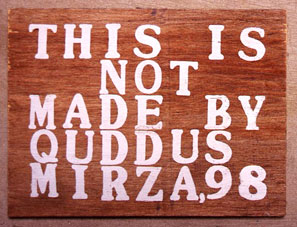 ‘The Anatomy of Power” 2006
‘The Anatomy of Power” 2006
Quddus Mirza works with his fellow Nadia Shaukat to create site-specific work about the impact of power in the lives of people who live under certain political conditions. The work will serve as a critique of the desire to rule, shared by many, besides addressing the current political/global situation. The site-specific work will include images scattered on the gallery walls with a few pieces placed close to these.
Hamra Abbas
Hamra Abbas studied at National College of Arts before going to Berlin, where she studied art and worked as an independant artist. She has shown in Pakistan and abroad. She is based in Islamabad.
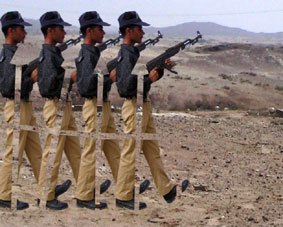 “Left Right”. 2006
“Left Right”. 2006
This is a single channel projection about the soldier in the open space, yet the interplay of images is poetic and transcneds from a specific reading of the work. She uses minimal sensibilty in her video, which has a universal appeal/understanding. In her video, the soldier marches inside the clouds, fields and rivers.
“Battle Scenes”. 2006
The animation is accompanied with two sets of digital prints, each set has two images. In this body of work, she has used traditional miniature paintings and recreated the people in war and their postures by photographing actual individuals from streets of London. In a way, this is a comment upon the continuity of all kinds of war, including the historic battles for territories and the present day war on terror.
Huma Mulji
Huma Mukji studied at Indus Valley School of Art and Architecture and now works as an art educationist in Lahore. She has exhibited both in Pakistan and abroad. Now lives in Lahore (Pakistan).
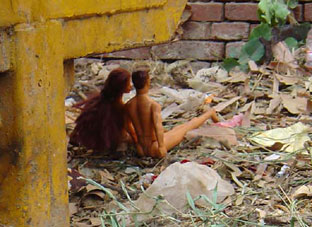 «Trespassing”. 2006
«Trespassing”. 2006
In her series of digital prints she has photographed male and female dolls outside, in public spaces and in intimate poses. Some of these dolls are seen by spectators, while a few of these are placed near rubbish bins or in the bushes.
All of these challange the norms of traditional Islamic society, which discourage youth to mix freely in public spaces. Huma with her doll imagery seems to be reasserting the desires and rights, yet the choice of dolls is symbolic and playful.
Bani Abidi
Bani Abidi studied at National College of Arts and later acquired MFA from Chicago Institute of Art, USA. She divides her time between South Asia and Europe. Now lives in Budapest.
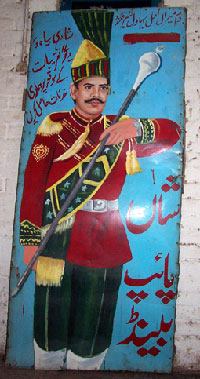 “Shaan Pipe Band”. 2006
“Shaan Pipe Band”. 2006
In this video works, she has captured the music lessions of a local band, and she asked them to learn to play American anthem. Those illiterate folk, who perform on minimum wages, are trying to learn American anthem. This simple, but carefully crafted piece, is a comment upon the current hegemony of the US on other nations, especially of the third world Muslim countries.
“The Boy who Got Tired of Posing”. 2006
These are two sets of digital prints. In these pictures children are dressed as Arab warriors, holding card board swords. The work alludes to the deeply embedded sentiments in our youth to identify with the house of Islam and on doing so, to assume a herioc character/role, that can read or end up as modern day terrorist. The work is subtle on the one hand these pictures look like ordinary photographs, but at the same instant, these have strong political undertones.
INDIA:
Vibha Galhotra
Vibha Galhotra cCompleted her BFA in Print-Making from Govt. College of Arts, Chandigarh (1999) and MFA in Print-Making from Kala Bhavan, Visva Bharati, Santiniketan (2001). She was awarded Inlaks Foundation Fine Arts Award (2003-2005) and honored with National scholarship, HRD, Government of India-2001-02.
She took part in international exhibitions: 44th, 45th, 46th National Annual Art Exhibition; Bharat Bhavan International Print Biennial, India (2003); Moscow (2003); Miniprint De Sarajevo (2004); “Gut”, Gustle-An Organization for Art in Landscape, Austria (2002); “Europas Parkas”, Lithuania (2001). She lives in Delhi.
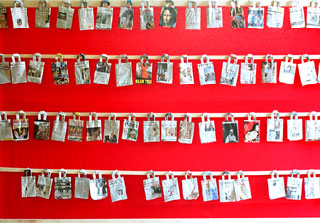 «Where do we come from,
where are we going…”. 2006
«Where do we come from,
where are we going…”. 2006
“My work basically deals with the issues and situations around in the society, I am living in. So, I call all my works sites - specific. Here I’ll be presenting the works which question the humanity in society. I call it 24x7 Bazaar where we all have questions that have never been asked and so never answered. So, I try to deal with those questions in an indirect manner”. (Vibha Galhotra)
Vivan Sundaram
Studied painting in Baroda and London in the 1960’s. Since 1990 he has turned to making artworks as sculpture, installation, photography and video. He has exhibited in the Biennial’s of Havana, Johanesburg, Kwangju, Shanghai, Queensland (Australia), Seville and Taipei. Has participated in shows in London, New York, Vancouver, Paris, Tokyo, Munich, Vienna. He has had solo shows in many cities of India as well as in London, Paris, Toronto, Montreal. He also has curated many exhibitions and organized a number of artist workshops, both national and international. Lives in Delhi.
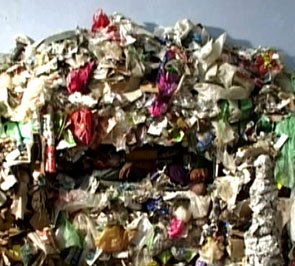 ‘The Brief Ascension
of Marian Hussain’. 2005
‘The Brief Ascension
of Marian Hussain’. 2005
The main image is a three meter tall mountain of garbage, in which we can see a barely discernable figure. After every 10 seconds, the body is seen higher up in the pile, until the young bare chested boy is seen lying on the flattened out top. Marian Hussain then stretches himself, raising his arms towards the sky (hands out of the frame). But the ascension is incomplete, as the cycle of the returning to the base of the heap, to rise once again, for another day, another journey, to make a new life, begins.
Tushar Joag
Tushar Joag received his bachelors in sculpture from Sir J.J. School of Arts, Mumbai, and his masters from the Faculty of Fine Arts, M.S. University, Baroda. Had residency at the Rijksakademie van Beeldende Kunsten, Amsterdam.
He has shown in Delhi, Kalcutta, Bombay in India, and in international exhibitions. He was one of the founder members of the artists’ initiative, and the co-facilitator for culture for the World Social Forum 2004. He has curated exhibitions and workshops at the World Social Forum 2006 in Brazil and in 2007 in Kenya.
 «Realty Itch», video. 2006
«Realty Itch», video. 2006
Realty Bite, Realty Sting and Realty Itch are digitally generated images of the greed, the parasiting and the violence meted out on the city for acquiring the prized land in Bombay.
The proposed makeover of the city gives the elected officials a chance to collude with the builder lobby and create a ‘global’ city where the locals have no place.
Sharmila Samant
Graduated with a Bachelor of Fine Arts from J.J. School of Fine Arts in 1989. Took part in major exhibitions: “Century City” at Tate Modern in 2001; Body/City in the House of World Cultures, Berlin; “Seed to the Tree”, Henie Onstad Kunstsenter Oslo, Norway; “Migrating Identity-Transmission/Reconstruction”, Arti et Amicitiae, Amsterdam; “Mirror Worlds” Contemporary Video from Asia, ACP, Australia; “Subcontingent The Indian Subcontinent in Contemporary Art”, Fondazione Sandretto Re Rabaudengo, Torino, Italy; Liverpool Biennale, UK; The Werkleitz Biennial: Common Property, Germany, 2004.
As the founder of Open Circle she has conceptualised and coordinated its participation at Pabellon de Cuba in Vedado, Havana Biennial 2003, Yokohoma Triennial 2005, Busan Biennale, Biennale of the Canaries, 2006. Lives and works in Mumbai.
“Briefcase Of the Mumbai Boogieman (BOMB)”. 2007
 Fear: I’m scared maybe the vehicle that has stopped next to me is going to blow up. I don’t know, maybe that is the guy, he wants to kill himself. To take one’s child to the cinema, to go shopping with ones friends to a market… if one’s spouse is late and has taken the train/subway… The fight against terrorism to some extent depends on luck. If by chance one of us sees something suspicious and reports it, but, if no one does, a blast happens. But then again every abandoned suitcase or attaché case is obviously not a bomb waiting to go off.
Fear: I’m scared maybe the vehicle that has stopped next to me is going to blow up. I don’t know, maybe that is the guy, he wants to kill himself. To take one’s child to the cinema, to go shopping with ones friends to a market… if one’s spouse is late and has taken the train/subway… The fight against terrorism to some extent depends on luck. If by chance one of us sees something suspicious and reports it, but, if no one does, a blast happens. But then again every abandoned suitcase or attaché case is obviously not a bomb waiting to go off.
Anxiety: The paranoia makes us headless. It makes us consider identity cards and massive surveillance, it makes us treat all Muslims, Asians, the Other as suspects, and it makes us vote for right wing politicians, want changes in foreign policy, and give massive powers to the state, further clamp down our airports with mindless security procedures. It makes us condone torture of innocent people because there’s a chance they might be guilty. Toys, radios, liquids, shoes, tiffin-boxes, pressure-cookers, planes, knapsacks, any personal or household object or fellow humans could be a bomb in disguise. Its components can be easily bought in any household store without provoking suspicion. So… does our routine have to include waiting because the road or airport gets blocked everytime an abandoned object is found?
Pushpamala N.
Pushpamala N. took part in exhibitions in Perth, Australia (1997); Montreal and Vancouver, Canada (2001). She had solo shows in Bose Pacia Gallery, New York, USA (2004); Vadehra Art Gallery, New Delhi, India (2005); Lumiere Hall, University of Westminster, London, UK (2005); Espace Croise, Roubaix, France (2006).
“Indian Lady”, video. 1997
 “In “Indian Lady”, a routine postcard of a Mumbai skyscraper line at night reflected in the sea was copied by a commercial painter on a large cloth curtain in the garish colours typical to backdrops of bazaar photo-studios. The fake nature of the prop underscores the amusingly exaggerated filmi charms and dancing movements of the artist attired in a sumptuous traditional sari and wearing artificial flowers in her wig bun. Her coy smiles and sweet gestures of docility repeat over and over again, the short film running in a loop, to suggest the mechanical manner in which these acts have been internalised by women, and to push to absurdity the unnaturally adopted feminine grace that suits the comforts of a vastly patriarchal and hypocritical society. The modernity of the high-rise structures, too, emphasises the antiquated canons of behaviour Pushpamala is ridiculing together with their roots in domestic, societal and cultural practice”. (Marta Jacomovicz, Bangalore, 2004).
“In “Indian Lady”, a routine postcard of a Mumbai skyscraper line at night reflected in the sea was copied by a commercial painter on a large cloth curtain in the garish colours typical to backdrops of bazaar photo-studios. The fake nature of the prop underscores the amusingly exaggerated filmi charms and dancing movements of the artist attired in a sumptuous traditional sari and wearing artificial flowers in her wig bun. Her coy smiles and sweet gestures of docility repeat over and over again, the short film running in a loop, to suggest the mechanical manner in which these acts have been internalised by women, and to push to absurdity the unnaturally adopted feminine grace that suits the comforts of a vastly patriarchal and hypocritical society. The modernity of the high-rise structures, too, emphasises the antiquated canons of behaviour Pushpamala is ridiculing together with their roots in domestic, societal and cultural practice”. (Marta Jacomovicz, Bangalore, 2004).
Suresh B.V.
Suresh B.V. studied in Bangalore, followed by a diploma and post diploma at M.S. University in Baroda. He later went to the Royal College of Art in London to do his masters. Suresh has participated in various group shows and solo exhibitions in India. His video works have been screened at South Asia Film Festival in Nepal, and at Apejay Media Gallery, New Delhi. He has participated in an international workshop ‘Khoj’ in New Delhi. Presently, he teaches painting at the Faculty of Fine Arts in Baroda.
“Bread”, videoinstallation. 2006
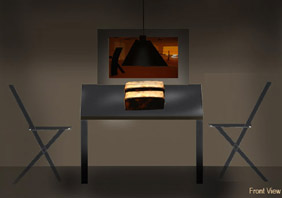 The installation is an invitation to contemplate burnt bread, which conjures up an everyday scene. The film ‘Retakes of the Shadow’ offers an entry into the nature of violence, its multiple levels and forms, its strategies and tactics and the manner in which everyday life comes to be organized in its terms. Standing in metonymic relation with the Best Bakery ‘case’ that has now became the public face of the 2002 violence in Gujarat, the bread allows for the circulation of other meanings – as common food, as the outcome of laboring bodies. Media focus on the legalities of the ‘case’ seem to have erased the brutality of those deaths, the burnt crust returns us to that moment.
The installation is an invitation to contemplate burnt bread, which conjures up an everyday scene. The film ‘Retakes of the Shadow’ offers an entry into the nature of violence, its multiple levels and forms, its strategies and tactics and the manner in which everyday life comes to be organized in its terms. Standing in metonymic relation with the Best Bakery ‘case’ that has now became the public face of the 2002 violence in Gujarat, the bread allows for the circulation of other meanings – as common food, as the outcome of laboring bodies. Media focus on the legalities of the ‘case’ seem to have erased the brutality of those deaths, the burnt crust returns us to that moment.
Note: 14 people were burnt to death at Best Bakery, Vadodara, Gujarat, during the anti-Muslim violence of 2002 which killed more than 2000 people. (Ms. Deepta Achar, Baroda, 2007)
Tallur L.N.
Tallur L.N. graduated from Leeds Metropolitan University, UK. MA, Maharaja Sayajirao University of Baroda, Gujrat, and Chamarajendra Academy of Visual Arts, Mysore University, India.
 Solo: Seoul, South Korea (2007); Bose Pacia Gallery, New York (2000); University of Baroda (1998); Gallery Chemould, Mumbai (1999). Group: The Armory show, New York (2007); Arco2007, Spain (2007); “Subcontingent”, Foundazione Sandretto Re Rebaudengo, Italy (2006); “Edge of Desire: recent art in India” (Western Australia, 2004, Asia Society and Queens museum, New York, 2005, Tamayo Museum, Mexico, 2005, Museum of Modernity, Monterrey Mexico, 2006, Asian Art Museum of San Franscisco, USA, 2006, Royal Ontario Museum, Toronto, 2007); Busan Biennial, South Korea (2004); Leeds Metropolitan University Gallery, GB (2002); Art in the World, Paris, France (2000), etc.
Solo: Seoul, South Korea (2007); Bose Pacia Gallery, New York (2000); University of Baroda (1998); Gallery Chemould, Mumbai (1999). Group: The Armory show, New York (2007); Arco2007, Spain (2007); “Subcontingent”, Foundazione Sandretto Re Rebaudengo, Italy (2006); “Edge of Desire: recent art in India” (Western Australia, 2004, Asia Society and Queens museum, New York, 2005, Tamayo Museum, Mexico, 2005, Museum of Modernity, Monterrey Mexico, 2006, Asian Art Museum of San Franscisco, USA, 2006, Royal Ontario Museum, Toronto, 2007); Busan Biennial, South Korea (2004); Leeds Metropolitan University Gallery, GB (2002); Art in the World, Paris, France (2000), etc.
“Souvenir maker:
designed in America, conceptualised in India, made in China, sponsored by Korea,
Yes...
we are conditioned to think under flags ...” 2005